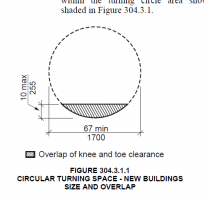The steering technology is outmoded and steering could and should be done much more efficiently. See the commentary starting on MS-Word page 6 from ICC on this subject at:
http://www.iccsafe.org/wp-content/uploads/asc_a117/C03.doc
Excerpts:
"In examining what design features were driving the space to be so large it became apparent that lack of differential steering in scooters and some power chairs was a major factor. Differential steering, as found in manual wheelchairs and center wheel power wheelchairs, is the ability to drive one drive wheel forward while the other goes backward. Where both wheels are driven by a common motor or direct drive transmission both wheels must go in the same direction, hence the turning radia are much larger.
...This observation raises the question – should the built environment be changed to accommodate poorly designed wmds [wheelchair mobility devices] or ought those choosing poorly designed wmds be informed that their vehicle may not be well accommodated? The analogy is the parking lot at the grocery store. If you choose to drive a stretch limo, RV, bus, or other vehicle that is bigger than a typical parking space you are welcome to shop, but don't expect a parking space near the entry. Ultimately this is a political and not a technical question.
...The Committee recognized that increasing the base dimensions of the circular turning space and the clear floor space have space and therefore cost implications throughout a building design and the design of site features, Specifically mentioned during the debate were dwelling units, kitchens and single occupant toilet/bathrooms."
Since it's a political and not technical question, then my political opinion is that scooters, etc. without differential steering are outmoded and we should not be designing the built environment around inefficient technology, any more that we should provide turning space for a golf cart or a horse inside a restroom.

